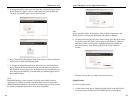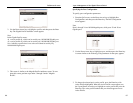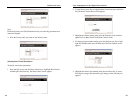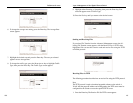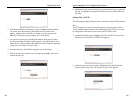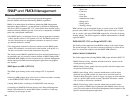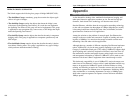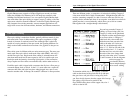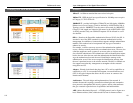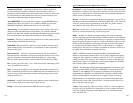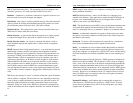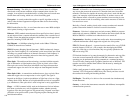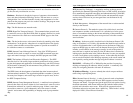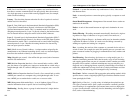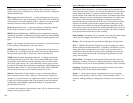
111
Layer 2 Management 4-Port Gigabit Ethernet Switch
ProConnect II
®
Series
Gigabit Ethernet runs at speeds of 1Gbps (Gigabit per second), ten times
faster than 100Mbps Fast Ethernet, but it still integrates seamlessly with
100Mbps Fast Ethernet hardware. Users can connect Gigabit Ethernet hard-
ware with either fiber optic cabling or copper Category 5 cabling, with fiber
optics more suited for network backbones. As the new Gigabit standard grad-
ually integrates into existing networks, current computer applications will
enjoy faster access time for network data, hardware, and Internet connections.
Fiber optic cabling is made from flexible, optically efficient strands of glass
and coated with a layer of rubber tubing, fiber optics use photons of light
instead of electrons to send and receive data. Although fiber is physically
capable of carrying tetrabits of data per second, the signaling hardware cur-
rently on the market can handle no more than a few gigabits of data per sec-
ond.
Fiber cables come in different with two main connector types. The most com-
monly used fiber optic cable is multi-mode fiber cable (MMF), with a 62.5
micron fiber optic core. Single-mode fiber cabling is somewhat more effi-
cient than multi-mode but far more expensive, due to its smaller optic core
that helps retain the intensity of traveling light signals. A fiber connection
always require two fiber cables: one transmits data, and the other receives it.
Each fiber optic cable is tipped with a connector that fits into a fiber port on
a network adapter, hub, or switch. In the U. S., most cables use a square SC
connector that slides and locks into place when plugged into a port or con-
nected to another cable. In Europe, the round ST connector is more prevalent.
110
There are different grades, or categories, of twisted-pair cabling. Category 5
is the most reliable and is highly recommended. Straight-through cables are
used for connecting computers to a hub. Crossover cables are used for con-
necting a hub to another hub (there is an exception: some hubs have a built-in
uplink port that is crossed internally, which allows you to link or connect
hubs together with a straight-through cable instead).
You can buy pre-made Category 5
cabling, or cut and crimp your own.
Category 5 cables can be purchased
or crimped as either straight-through
or crossover cables. A Category 5
cable has 8 thin, color-coded wires
inside that run from one end of the
cable to the other. All 8 wires are
used. In a straight-through cable,
wires 1, 2, 3, and 6 at one end of the
cable are also wires 1, 2, 3, and 6 at
the other end. In a crossover cable,
the order of the wires change from
one end to the other: wire 1 becomes
3, and 2 becomes 6. See the diagrams
on the next page for
more detailed informa-
tion on straight-through
and crossover cabling.
To determine which wire is wire number 1, hold the
cable so that the end of the plastic RJ-45 tip (the part
that goes into a wall jack first) is facing away from
you. Face the clip down so that the copper side faces up
(the springy clip will now be parallel to the
floor).When looking down on the copper side, wire 1
will be on the far left.
Twisted-Pair Cabling
About Gigabit Ethernet
Fiber Optic Cabling



